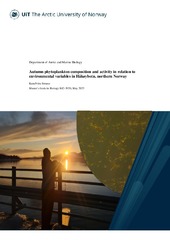| dc.contributor.advisor | Rolf Rudolf Gradinger | |
| dc.contributor.author | Strausz, Kata Nora | |
| dc.date.accessioned | 2025-07-16T08:37:25Z | |
| dc.date.available | 2025-07-16T08:37:25Z | |
| dc.date.issued | 2025 | |
| dc.description.abstract | Phytoplankton are an important part of marine food webs. They are subject to environmental factors such as light, temperature, salinity, nutrient concentrations, and stratification, all of which are rapidly changing with the warming climate. In the Arctic, both abiotic environment and phytoplankton community composition show strong seasonal trends. There has been a high interest in understanding what regulates Arctic plankton population dynamics, focusing on the highly productive spring bloom. Knowledge about the autumn and winter transition is however scarce. In this study, I attempt to fill this gap by describing phytoplankton seasonality in Tromsø, in Northen Norway, with a focus on autumn dynamics. We have gathered environmental data and phytoplankton net samples near the shore in Håkøybotn. I tested the correlation between cell abundances and nutrient, salinity, temperature, chlorophyll a, and irradiance data. I also evaluated the photosynthetic activity of concentrated water samples. For that I used rETRmax and alpha values of light curve measurements, which were created by pulse amplitude-modulated (PAM) fluorescence.
The results showed seasonal trends of environmental variables, that were typical for a temperate Arctic coastal location. A dominance of pennate diatoms was found in early summer, followed by low cell counts and small flagellate abundance for the rest of the season. Then autumn cell counts peaked in the middle of September, with the highest proportion of Leptocylindrus spp. within the population. Plankton abundance gradually declined after September with an increasing dominance of flagellates and choanoflagellates. Chlorophyll concentrations were elevated between the end of August until the end of October, which coincides with the phytoplankton count peak but might point out other photosynthetic groups as well, that were unaccounted for in this study. Canonical correspondence analysis showed that most variation in cell count data was explained by salinity and water temperature. However, the correlation was statistically not significant. The alpha values were comparable to values of other highly active plankton communities, and rETRmax was higher than at other mentions in the literature. Photosynthetic activity exhibited a slight decline at the beginning of autumn; however, this trend was not statistically significant due to the limited sample size. Several light curve measurements were unsuccessful as chlorophyll a concentration approached the sensor’s detection limit, particularly towards the end of the sampling period.
Keywords: phytoplankton, autumn bloom, PAM fluorescence, seasonal dynamics, Northern Norway | |
| dc.description.abstract | Phytoplankton are an important part of marine food webs. They are subject to environmental factors such as light, temperature, salinity, nutrient concentrations, and stratification, all of which are rapidly changing with the warming climate. In the Arctic, both abiotic environment and phytoplankton community composition show strong seasonal trends. There has been a high interest in understanding what regulates Arctic plankton population dynamics, focusing on the highly productive spring bloom. Knowledge about the autumn and winter transition is however scarce. In this study, I attempt to fill this gap by describing phytoplankton seasonality in Tromsø, in Northen Norway, with a focus on autumn dynamics. We have gathered environmental data and phytoplankton net samples near the shore in Håkøybotn. I tested the correlation between cell abundances and nutrient, salinity, temperature, chlorophyll a, and irradiance data. I also evaluated the photosynthetic activity of concentrated water samples. For that I used rETRmax and alpha values of light curve measurements, which were created by pulse amplitude-modulated (PAM) fluorescence.
The results showed seasonal trends of environmental variables, that were typical for a temperate Arctic coastal location. A dominance of pennate diatoms was found in early summer, followed by low cell counts and small flagellate abundance for the rest of the season. Then autumn cell counts peaked in the middle of September, with the highest proportion of Leptocylindrus spp. within the population. Plankton abundance gradually declined after September with an increasing dominance of flagellates and choanoflagellates. Chlorophyll concentrations were elevated between the end of August until the end of October, which coincides with the phytoplankton count peak but might point out other photosynthetic groups as well, that were unaccounted for in this study. Canonical correspondence analysis showed that most variation in cell count data was explained by salinity and water temperature. However, the correlation was statistically not significant. The alpha values were comparable to values of other highly active plankton communities, and rETRmax was higher than at other mentions in the literature. Photosynthetic activity exhibited a slight decline at the beginning of autumn; however, this trend was not statistically significant due to the limited sample size. Several light curve measurements were unsuccessful as chlorophyll a concentration approached the sensor’s detection limit, particularly towards the end of the sampling period.
Keywords: phytoplankton, autumn bloom, PAM fluorescence, seasonal dynamics, Northern Norway | |
| dc.identifier.uri | https://hdl.handle.net/10037/37712 | |
| dc.identifier | no.uit:wiseflow:7267549:61779935 | |
| dc.language.iso | eng | |
| dc.publisher | UiT The Arctic University of Norway | |
| dc.rights.holder | Copyright 2025 The Author(s) | |
| dc.rights.uri | https://creativecommons.org/licenses/by/4.0 | en_US |
| dc.rights | Attribution 4.0 International (CC BY 4.0) | en_US |
| dc.title | Autumn phytoplankton composition and activity in relation to environmental variables in Håkøybotn, northern Norway | |
| dc.type | Master thesis | |


 English
English norsk
norsk
